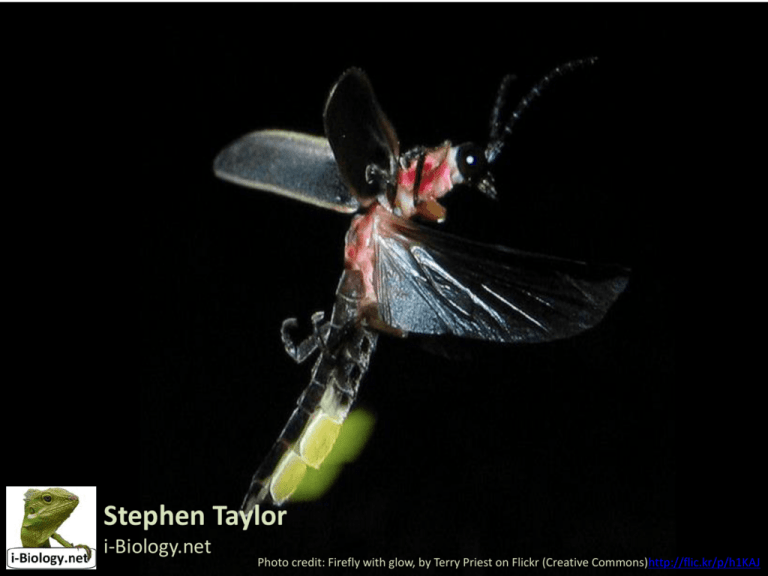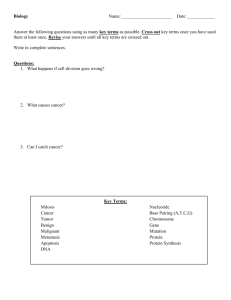11-3-5-protein synthesis-student - LaPazColegioWiki2013-2014
advertisement

Stephen Taylor i-Biology.net Photo credit: Firefly with glow, by Terry Priest on Flickr (Creative Commons)http://flic.kr/p/h1KAJ http://learn.genetics.utah.edu/content/molecules/firefly/ 3.5.1 • Compare the structure of RNA and DNA – (with respect to the type of sugar, the bases and the number of strands) 3.5.2 • Outline DNA transcription in terms of the formation of an RNA strand complimentary to the DNA strand by RNA polymerase Transcription animation: http://www.stolaf.edu/people/giannini/flashanimat/molgenetics/transcription.swf Translation animation: http://www.stolaf.edu/people/giannini/flashanimat/molgenetics/translation.swf 3.5.3 • Describe the genetic code in terms of codons composed of triplets of bases 3.5.4 • Explain the process of translation, leading to polypeptide formation – Include the roles of mRNA, tRNA, codons, anticodons and amino acids DNA and Protein Synthesis • DNA contains the genetic information to make amino acids • Amino acids combine to make proteins • These proteins determine the physical traits of an organism and control cellular functions. • Proteins do everything, and DNA gets all the credit! • Think of them as tiny minions who do all the work DNA and Protein Synthesis FROM DNA TO PROTEIN… •Think of DNA as a blueprint for your body •A lot of the blueprint has to do with protein building, but not all of it •To create a protein from the blueprint involves two main processes •1. TRANSCRIPTION •The essential parts of the blueprint (DNA) for protein building are copied (transcribed) by an architect (mRNA) and transported to the construction site •2. TRANSLATION •The protein blueprint (mRNA) is given to the builders (ribosomes) who translate the DNA code into the PROTEIN CODE to build proteins RNA - the messenger *single strand *ribose sugar *contains no thymine, uracil instead *follows base pair rule DNA: A T A G C G RNA: U A U C G C RNA carries the "message" to the ribosomes, where proteins are made CODES • DNA code: – 4 possible bases (ATCG) – Nucleotides in various combinations connect together and pair forming a DNA double helix (double stranded) • • RNA code: – 4 letters (AUCG) • – – • Are connected to deoxyribose and phosphate forming nucleotides Are connected to ribose and phosphate forming nucleotides Nucleotides in various combinations connect together forming a RNA chain (SINGLE stranded) Groups of 3 nucleotides (CODONS) make an RNA word PROTEIN CODE– – – – – EACH CODON CODES FOR AN AMINO ACID All protein words are 3 letters long (ie: ATT, CAG, GGC) Each 3 letter word (codon) codes for a specific amino acid There are 20 possible amino acids » THEY ARE THE SUBUNIT OF PROTEINS Chains of amino acids make a PROTEIN DNA and Protein Synthesis • Codon: three bases code for a specific amino acid: ex: AAA = Lysine • The codons code for 20 amino acids • Just like the alphabet has 26 letters to make all the words we know, the 20 amino acids that, when combined in different ways, make all the different proteins found in living organisms • The codons are the template for protein synthesis, which takes place on the ribosomes (rRNA) in the cytoplasm DNA and Protein Synthesis – Codons and amino acids ile Name the Amino Acid: Start UAU Tyrosine CCG Proline AGU Serine GCA Alanine • • • • Protein synthesis- Youtube http://www.youtube.com/watch?v=NJxobgkPEAo Protein synthesis 2 – Youtube http://www.youtube.com/watch?v=1fiJupfbSpg • • • Cow dna - http://www.biologycorner.com/worksheets/DNAcontrols.html Genetics bio corner: http://www.biologycorner.com/lesson-plans/genetics/ DNA and Protein Synthesis – Codons and amino acids Name the Amino Acid: UAU CCG Tyrosine AGU Proline GCA Serine ile Alanine DNA and Protein Synthesis But… How does the information get from the DNA to the cytoplasm? mRNA DNA and Protein Synthesis - Transcription Transcription: 1) DNA unzips 2) mRNA (messenger ribonucleic acid) copies info from DNA using base pairings • 3) RNA is different from DNA a) Single stranded, not double stranded b) Instead of deoxyribose, it has ribose c) instead of Thymine, it uses Uracil mRNA carries the genetic code from the nucleus to the ribosome in the cytoplasm DNA and Protein Synthesis - Translation Translation: 1) rRNA (ribosomal RNA) attaches to mRNA and starts reading the codons 2) tRNA (transfer RNA) – carries no acids and attaches them to the growing protein chain by matching its complementary anticodon with the mRNA codon 3) When protein production is complete, the ribosome releases the protein chain DNA and Protein Synthesis - Summary DNA and Protein Synthesis Practice making mRNA using the DNA template A T T A C A C U A A U G U mRNA DNA and Protein Synthesis • Amino acids are linked together in the same order as the codons , creating a protein chain • Just like linking letters to make words, linking amino acids makes proteins mRNA CUA AUG UGC Amino Acid Amino Acid Amino Acid Go To This Website • http://learn.genetics.utah.edu/content/molec ules/transcribe/ http://learn.genetics.utah.edu/content/begin/dna/firefly/ Fill in the blanks on the following slide 3.5.5 • Discuss the relationship between one gene and one polypeptide For more resources & links. Please consider a donation to charity via Biology4Good. Click here for more information about Biology4Good charity donations. This is a Creative Commons presentation. It may be linked and embedded but not sold or re-hosted.







